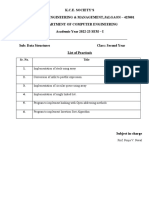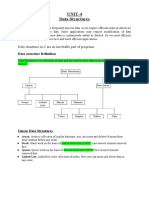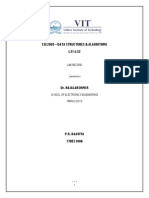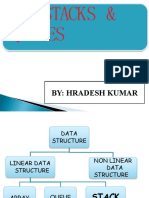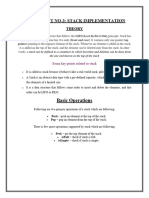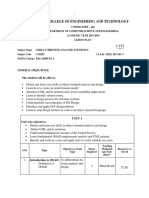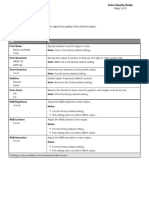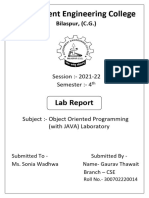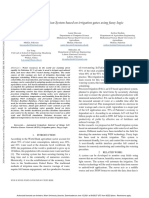Data Struc Lab Manul
Uploaded by
balakirubaData Struc Lab Manul
Uploaded by
balakirubaData structures and algorithms Lab manual for II year IT
Department of Information Technology
LAB MANUAL
IT2205 – Data Structures and Algorithm Lab
(III Semester IT)
Prepared by,
L.Priya
(Senior Lecturer /IT)
RAJALAKSHMI ENGINEERING COLLEGE
Rajalakshmi Nagar, Thandalam, Chennai – 602 105
Department of IT, REC, Thandalam.
Data structures and algorithms Lab manual for II year IT
INDEX
1. Array Implementation Of Stack
2. Application Of Stack – Conversion Of Infix To Postfix
3. Implementation Of Linear Queue Using Arrays
4. Array Implementation Of Circular Queue
5. Linked List Implementation Of Stack
6. Singly linked list – Linked list implementation
7. Doubly linked list – Linked list implementation
8. Polynomial Manipulation
9. Tree Traversals
10. Expression Tree
11. Priority Queue Using Heap
12. Hashing Technique
13. Dijkstra’s Algorithm
14. Back tracking algorithm – knap sack problem
Department of IT, REC, Thandalam.
Data structures and algorithms Lab manual for II year IT
Ex. no.: 1
Date :
ARRAY IMPLEMENTATION OF STACK
Aim
To write a C-program to implement stack using array data structure.
And perform the following stack operations
1. POP
2. PUSH
3. PEEP
Algorithm
STEP 1:Start
STEP 2:Initialize stack, will=1,i, num
STEP 3:Add element in stack
PUSH(S,TOP,X)
3.a. [Check overflow condition]
If(TOP>=N) then
Write(“Stack is full”)
3.b. [Insert element]
[Increment TOP]
TOP <- TOP+1
S[TOP]<- X
3.c. [Finish the process]
STEP 4: Delete element in stack
POP(S,TOP)
4.a. [Check for underflow condition]
If(TOP <- 0) then
Write(“Stack is empty”)
Department of IT, REC, Thandalam.
Data structures and algorithms Lab manual for II year IT
4.b. [Delete element]
[Decrement TOP]
TOP<- TOP-1
Delete S[TOP+1]
4.c.[Finish the process]
STEP 5:Stop
Coding:
#include<stdio.h>
#include<conio.h>
#define size 10
int stack[size],top=0,b;
int res;
void push();
void pop();
void display();
void main()
{
int c;
clrscr();
printf("\n1.Push\n2.Pop\n3.Display");
do
{
printf("\n\nEnter your Choice :: ");
scanf("%d",&c);
switch(c)
{
case 1:
Department of IT, REC, Thandalam.
Data structures and algorithms Lab manual for II year IT
push();
break;
case 2:
pop();
break;
case 3:
printf("\n\nContents of stack is \t");
display();
break;
default:
printf("\nInvalid Choice......");
exit(0);
}
}while(c<4);
getch();
}
void push()
{
if(top>=size)
{
printf("\nStack Overflow");
return;
}
else
{
printf("\nEnter the number to be pushed into the stack :: ");
scanf("%d",&b);
top++;
Department of IT, REC, Thandalam.
Data structures and algorithms Lab manual for II year IT
stack[top]=b;
printf("\nNumber pushed is %d",stack[top]);
return;
}
}
void pop()
{
if(top==0)
{
printf("\nStack Underflow");
return;
}
else
{
res=stack[top];
top--;
printf("\nDeleted element is %d",res);
return;
}
}
void display()
{
int i;
if(top==0)
{
printf("\nStack Underflow");
return;
}
Department of IT, REC, Thandalam.
Data structures and algorithms Lab manual for II year IT
for(i=top;i>0;i--)
printf("%d , ",stack[i]);
}
Output:
1.Push
2.Pop
3.Display
Enter your Choice :: 1
Enter the number to be pushed into the stack :: 3
Number pushed is 3
Enter your Choice :: 1
Enter the number to be pushed into the stack :: 5
Number pushed is 5
Enter your Choice :: 3
Contents of stack is 5,3,
Enter your Choice :: 2
Department of IT, REC, Thandalam.
Data structures and algorithms Lab manual for II year IT
Deleted element is 5
Enter your Choice :: 3
Contents of stack is 3,
Enter your Choice :: 8
Invalid Choice......
Department of IT, REC, Thandalam.
Data structures and algorithms Lab manual for II year IT
Ex. No.:2
Date :
CONVERSION OF INFIX EXPRESSION TO POSTFIX
Aim
To write a C-program to convert the given infix expression to its postfix format.
Algorithm
STEP 1: Start
STEP 2: Initialize the stack.
STEP 3: While (INSTR!= NULL)
STEP 4: CH= get the character from INSTR.
STEP 5: If( CH= = operand) then
append CH int POSTSTR
else if(CH = = ‘(‘) then
push CH into stack
else if(CH = =’)’) then
pop the data from the stack and append the data into POSTSTR until we get
‘(‘ from the stack
else
while(precedence (TOP) >= precedence (CH))
pop the data from stack and append the data into POSTSTR.
[End of while structure]
[End of if structure]
STEP 6: Push CH into the stack.
STEP 7: [End of second while structure]
Department of IT, REC, Thandalam.
Data structures and algorithms Lab manual for II year IT
STEP 8: pop all the data from stack and append data into POSTSTR.
STEP 9: Stop
Coding:
#include<stdio.h>
#include<conio.h>
int stack[20],top=0;
char inf[40],post[40];
void push(int);
void postfix();
char pop();
void main(void)
{
clrscr();
printf("\t\t\t****INFIX TO POSTFIX****\n\n");
printf("Enter the infix expression :: ");
scanf("%s",inf);
postfix();
getch();
}
void postfix()
{
int i,j=0;
for(i=0;inf[i]!=NULL;i++)
{
switch(inf[i])
{
case '+':
while(stack[top]>=1)
Department of IT, REC, Thandalam.
Data structures and algorithms Lab manual for II year IT
post[j++]=pop();
push(1);
break;
case '-':
while(stack[top]>=1)
post[j++]=pop();
push(2);
break;
case '*':
while(stack[top]>=3)
post[j++]=pop();
push(3);
break;
case '/':
while(stack[top]>=3)
post[j++]=pop();
push(4);
break;
case '^':
while(stack[top]>=4)
post[j++]=pop();
push(5);
break;
case '(':
push(0);
break;
case ')':
while(stack[top]!=0)
Department of IT, REC, Thandalam.
Data structures and algorithms Lab manual for II year IT
post[j++]=pop();
top--;
break;
default:
post[j++]=inf[i];
}
}
while(top>0)
post[j++]=pop();
printf("\nPostfix Expression is :: %s",post);
}
void push(int ele)
{
top++;
stack[top]=ele;
}
char pop()
{
char e;
e=stack[top];
top--;
switch(e)
{
case 1:
e='+';
break;
case 2:
e='-';
Department of IT, REC, Thandalam.
Data structures and algorithms Lab manual for II year IT
break;
case 3:
e='*';
break;
case 4:
e='/';
break;
case 5:
e='^';
break;
}
return(e);
}
Output:
Enter the infix expression :: (a+b)/(c*d)
Postfix Expression is :: ab+cd*/
Department of IT, REC, Thandalam.
Data structures and algorithms Lab manual for II year IT
Manual Calculation
SE EXPRESSION STACK RESULT FIELD
( (
A A
+ +,( A
B +,( AB
) ),( AB+
/ / AB+
( (,/
C (,/ AB+C
- -,(,/ AB+C
D -,(,/ AB+CD
+ +,(,/ AB+CD-
E +,(,/ AB+CD-E
) ),+,(,/ AB+CD-E+
+ +,/ AB+CD-E+/
F + AB+CD-E/F
- - AB+CD-E/F+
G - AB+CD-E/F+G
AB+CD-E/F+G-
Department of IT, REC, Thandalam.
Data structures and algorithms Lab manual for II year IT
Ex.no.3
Date:
IMPLEMENTATION OF LINEAR QUEUE USING ARRAYS
Aim
To write a C-program to implement linear queue data structure using arrays.
Algorithm
STEP 1: Start
STEP 2: [Include all header files]
STEP 3: [Declare the variables]
STEP 4: [If n->1 call the function Enqueue( )]
STEP 5: [If n->2 call the function Dequeue( )]
STEP 6: [If n->3 call the function Peep( )]
STEP 7: [If n->4 call the function Size( )]
STEP 8: [If n->5 call the function View( )]
STEP 9: [else Exit( )]
STEP 10: Stop
Algorithm for Enqueue( )
STEP 1: If[front= =rear]
Initialize front=rear=0
STEP 2: else rear=(rear+1)% qsize
Set queue[rear] =value
[return]
Algorithm for Dequeue( )
STEP 1: If[front = =rear]
1.1: temp=queue[front]
Department of IT, REC, Thandalam.
Data structures and algorithms Lab manual for II year IT
1.2: Initialize front=rear=-1
STEP 2:else
2.1: front=(front+1)% qsize
[return]
Algorithm for Peep( )
STEP 1:If [front= =rear]
STEP 1.1: temp=queue[front]
[return]
Algorithm for Size( )
STEP 1:If [front= =rear]
1.1: Set f=front
1.2: Set count=1
STEP 2: If [front!=rear]
2.1: front=(front+1)%qsize
2.2: set count=count+1
[return]
Algorithm for View( )
STEP 1: If [front = =rear]
Write (“Queue is empty”)
STEP 2: else
[display elements]
Department of IT, REC, Thandalam.
Data structures and algorithms Lab manual for II year IT
Coding:
#include<stdio.h>
#include<conio.h>
#define size 15
int queue[size],front=0,rear=0,b;
int res;
void enqueue();
void dequeue();
void display();
void main()
{
int c;
clrscr();
printf("\n1.Insertion\n2.Deletion\n3.Display");
do
{
printf("\n\nEnter your Choice :: ");
scanf("%d",&c);
switch(c)
{
case 1:
enqueue();
break;
case 2:
dequeue();
break;
Department of IT, REC, Thandalam.
Data structures and algorithms Lab manual for II year IT
case 3:
printf("\n\nContents of queue is \t");
display();
break;
default:
printf("\nInvalid Choice......");
exit(0);
}
}while(c<4);
getch();
}
void enqueue()
{
if(rear>=size)
{
printf("\nOverflow");
return;
}
else
{
printf("\nEnter the number to be entered :: ");
scanf("%d",&b);
rear++;
queue[rear]=b;
printf("\nNumber pushed is %d",queue[rear]);
if(front==0)
front=1;
return;
Department of IT, REC, Thandalam.
Data structures and algorithms Lab manual for II year IT
}
}
void dequeue()
{
if(front==0)
{
printf("\nUnderflow");
return;
}
else
{
res=queue[front];
if(front==rear)
{
front=0;
rear=0;
}
else
front++;
}
printf("\nDeleted element is %d",res);
return;
}
void display()
{
int i;
if(front==0)
{
Department of IT, REC, Thandalam.
Data structures and algorithms Lab manual for II year IT
printf("\nUnderflow");
return;
}
for(i=front;i<=rear;i++)
printf("%d , ",queue[i]);
}
Output:
1.Insertion
2.Deletion
3.Display
Enter your Choice :: 1
Enter the number to be entered :: 12
Number pushed is 12
Enter your Choice :: 1
Enter the number to be entered :: 2
Number pushed is 2
Enter your Choice :: 3
Contents of queue is 12 , 2 ,
Department of IT, REC, Thandalam.
Data structures and algorithms Lab manual for II year IT
Enter your Choice :: 2
Deleted element is 12
Enter your Choice :: 3
Contents of queue is 2,
Department of IT, REC, Thandalam.
Data structures and algorithms Lab manual for II year IT
Ex.No.4
Date:
ARRAY IMPLEMENTATION OF CIRCULAR QUEUE
Aim
To write a c program using arrays for implementing circular queue data structure.
Algorithm
Step 1: [Include All Header Files Required]
Step 2: [Define the array size as 5 and declare front and rear pointers]
Step 3: Declare the functions isEmpty() , isFull(), enqueue(), size(),dequeue(), peek() and
view()]
Step 4: [Call the functions]
Choice :1 CALL enqueue()
Choice :2 CALL deenqueue()
Choice :3 CALL peek()
Choice :4 CALL size()
Choice :5 CALL view()
Algorithm for isEmpty( )
Step 1: [Check for underflow]
If ( front -1 and rear -1 )
RETURN -1
Step 2: Else RETURN 0
[Finish the process]
Department of IT, REC, Thandalam.
Data structures and algorithms Lab manual for II year IT
Algorithm for isFull( )
Step 1: [Check for overflow]
If (= (rear+1)% qsize front )
RETURN -1
Step 2: Else RETURN 0
[Finish the process]
Algorithm for Enqueue( )
STEP 1: If[front= =rear]
Initialize front=rear=0
STEP 2: else rear=(rear+1)% qsize
Set queue[rear] =value
[return]
Algorithm for Dequeue( )
STEP 1: If[front = =rear]
1.1: temp=queue[front]
1.2: Initialize front=rear=-1
STEP 2:else
2.1: front=(front+1)% qsize
[return]
Department of IT, REC, Thandalam.
Data structures and algorithms Lab manual for II year IT
Algorithm for Peek( )
STEP 1:If [front= =rear]
STEP 1.1: temp=queue[front]
[return]
Algorithm for Size( )
STEP 1:If [front= =rear]
1.1: Set f=front
1.2: Set count=1
STEP 2: If [front!=rear]
2.1: front=(front+1)%qsize
2.2: set count=count+1
[return]
Algorithm for View( )
STEP 1: If [front = =rear]
Write (“Queue is empty”)
STEP 2: else
[display elements]
Coding:
#include<stdio.h>
#include<conio.h>
#define qsize 5
Department of IT, REC, Thandalam.
Data structures and algorithms Lab manual for II year IT
int queue[qsize],front=-1,rear=-1;
void enqueue(int value);
void dequeue();
void view();
void main()
{
int c,data,item;
clrscr();
printf("\n1.ENQUEUE\n2.DEQUEUE\n3.VIEW");
while(1)
{
printf("\n\nEnter your Choice :: ");
scanf("%d",&c);
switch(c)
{
case 1:
printf("\nEnter the element::");
scanf("%d",&data);
enqueue(data);
break;
case 2:
dequeue();
break;
case 3:
printf("\n\nContents of circular queue is \t");
view();
break;
default:
Department of IT, REC, Thandalam.
Data structures and algorithms Lab manual for II year IT
printf("\nInvalid Choice......");
exit(0);
}
}
}
int isfull()
{
extern int queue[],front,rear;
if(front==(rear+1)%qsize)
return(1);
else
return(0);
}
int isempty()
{
extern int queue[],front,rear;
if((front==-1)&&(rear==-1))
return(1);
else
return(0);
}
void enqueue(int value)
{
extern int queue[],front,rear;
if(isfull())
{
printf("\nOverflow");
return;
Department of IT, REC, Thandalam.
Data structures and algorithms Lab manual for II year IT
}
else
{
if(isempty())
front=rear=0;
else
rear=(rear+1)%qsize;
queue[rear]=value;
}
}
void dequeue()
{
int value;
extern int queue[],front,rear;
if(isempty())
printf("\n\nQueue is Empty");
else
{
value=queue[front];
printf("\nDequeue value is %d",value);
}
if(front==rear)
{
front=-1;
rear=-1;
}
else
front=(front+1)%qsize;
Department of IT, REC, Thandalam.
Data structures and algorithms Lab manual for II year IT
}
void view()
{
extern int queue[],front,rear;
int f;
if(isempty())
printf("\nUnderflow");
else
{
printf("\nFront-->");
for(f=front;f!=rear;f=(f+1)%qsize)
printf("%d ---> ",queue[f]);
printf("%d <--Rear",queue[f]);
}
if(isfull())
printf("\nQueue is full");
}
Output
1.ENQUEUE
2.DEQUEUE
3.VIEW
Enter your Choice :: 1
Enter the element::2
Department of IT, REC, Thandalam.
Data structures and algorithms Lab manual for II year IT
Enter your Choice :: 3
Contents of circular queue is
Front-->2 <--Rear
Enter your Choice :: 1
Enter the element::3
Enter your Choice :: 1
Enter the element::5
Enter your Choice :: 3
Contents of circular queue is
Front-->2 ---> 3 ---> 5 <--Rear
Enter your Choice :: 2
Dequeue value is 2
Enter your Choice :: 3
Contents of circular queue is
Front-->3 ---> 5 <--Rear
Department of IT, REC, Thandalam.
Data structures and algorithms Lab manual for II year IT
Enter your Choice :: 4
Invalid Choice......
Department of IT, REC, Thandalam.
Data structures and algorithms Lab manual for II year IT
Ex.no.:5
Date :
LINKED LIST IMPLEMENTATION OF STACK
Aim
To demonstrate linked list implementation of stack using a C program.
Algorithm
Step 1: [Include all the necessary header files]
Step 2: [Declare the Variables]
Step 3: Read operator
Step 4: IF opt 1 THEN
Step 4.1: READ n
Step 4.2: WHILE (n n-1)
Step 4.2.1: READ d
Step 4.2.2: CALL INSERT( start , d)
Step 4.3: [End of while Structure]
Step 5: IF opt 2 THEN
Step 5.1: READ x
Step 5.2: CALL del(start,x)
Step 6: IF opt 3 THEN
Step 6.1: READ x
Step 6.2: CALL FIND
Step 7: IF opt 4 THEN
Step 7.1: READ x
Department of IT, REC, Thandalam.
Data structures and algorithms Lab manual for II year IT
Step 7.2: CALL FINDPREVIOUS
Step 8: IF opt 5 THEN
Step 8.1: READ x
Step 8.2: CALL FINDNEXT(start, x)
Step 9: IF opt 6 THEN
CALL len(Start)
Step 10: IF opt 7 THEN
CALL printlist(Start)
Step 10: IF opt 8 THEN
CALL erase (Start)
Step 12: [End of Main]
Algorithm For Find(struct node*p, int x, int *pos)
Step 1: temp p
Step 2 :*pos 1
Step 3: IF ( TEMP NULL) THEN
RETURN NULL
ELSE
WHILE ( TEMP!= NULL && TEMP DATA!= X)
ASSIGN 1 TO *POS+1 AND TEMP’S LLINK FIELD TO TEMP
RETURN THE TEMP
Algorithm for Previous (struct node*p, int x)
Step 1: temp p
Step2: IF ( TEMP NULL) THEN
RETURN NULL
ELSE
WHILE (TEMP LINK != NULL && TEMP LINK DATA!= X)
Department of IT, REC, Thandalam.
Data structures and algorithms Lab manual for II year IT
ASSIGN TEMP’S LINK FIELD TO TEMP
RETURN THE TEMP
Algorithm For Find next(struct node*p, int x)
Step 1: temp p
Step2: IF ( TEMP NULL) THEN
RETURN NULL
ELSE
WHILE (TEMP LINK != NULL && TEMP DATA!= X)
ASSIGN TEMP’S LLINK FIELD TO TEMP
RETURN THE TEMP’S LINK FIELD
Coding:
#include<stdio.h>
#include<conio.h>
#include<stdlib.h>
push();
void pop();
void display();
struct node
{
int data;
struct node *next;
}*top=NULL;
Department of IT, REC, Thandalam.
Data structures and algorithms Lab manual for II year IT
void main()
{
int ch;
clrscr();
printf("\n\n1.Push\n\n2.Pop\n\n3.Display");
do
{
printf("\n\nEnter your Choice :: ");
scanf("%d",&ch);
switch(ch)
{
case 1:
push();
break;
case 2:
pop();
break;
case 3:
printf("\n\nContents of stack :: \t");
display();
break;
default:
printf("\n\nInvalid Choice......");
getch();
exit(0);
}
}while(ch<4);
getch();
Department of IT, REC, Thandalam.
Data structures and algorithms Lab manual for II year IT
}
push()
{
int x;
struct node *newnode;
newnode=malloc(sizeof(struct node));
printf("\n\nEnter the number to be pushed into the stack :: ");
scanf("%d",&x);
newnode->data=x;
if(top==NULL)
{
newnode->next=top;
top=newnode;
}
else
{
newnode->next=top;
top=newnode;
}
printf("\n\nNumber pushed is %d",x);
return(x);
}
void pop()
{
struct node *t;
if(top==NULL)
printf("\n\nStack Underflow");
else
Department of IT, REC, Thandalam.
Data structures and algorithms Lab manual for II year IT
{
t=top;
top=top->next;
printf("\nDeleted element is %d",t->data);
free(t);
}
getch();
}
void display()
{
struct node*i;
for(i=top;i!=NULL;i=i->next)
printf("%d , ",i->data);
if(top==NULL)
printf("Stack is empty");
getch();
}
Output:
1.Push
2.Pop
3.Display
Enter your Choice :: 1
Enter the number to be pushed into the stack :: 5
Department of IT, REC, Thandalam.
Data structures and algorithms Lab manual for II year IT
Number pushed is 5
Enter your Choice :: 1
Enter the number to be pushed into the stack :: 10
Number pushed is 10
Enter your Choice :: 3
Contents of stack :: 10 , 5 ,
Enter your Choice :: 2
Deleted element is 10
Enter your Choice :: 3
Contents of stack :: 5 ,
Enter your Choice :: 5
Invalid Choice......
Department of IT, REC, Thandalam.
Data structures and algorithms Lab manual for II year IT
Ex.no.:6
Date :
LINKED LIST IMPLEMENTATION OF SINGLY LINKED LIST
Aim:
To write a program to implement singly linked list using linked list.
Algorithm:
Step 1: initialize the list as null
Step 2: Display linked list operations insert, delete and display the result.
Step 3: If choice is 1 the read element to be inserted and call the insert function
Step 4: If choice is 2 then read element to be deleted and call the delete function
Step 5: If choice is 3 then call display function
Step 6: If choice is default the exit the program.
Program:
#include<stdio.h>
#include<conio.h>
#include<stdlib.h>
void insert(int x);
void deletion(int x);
void display();
struct node
{
int element;
struct node *next;
}*list=NULL,*p;
struct node *find(int s)
{
Department of IT, REC, Thandalam.
Data structures and algorithms Lab manual for II year IT
p=list->next;
while(p!=NULL && p->element!=s)
p=p->next;
return p;
}
struct node *findprevious(int s)
{
p=list;
while(p->next!=NULL && p->next->element!=s)
p=p->next;
return p;
}
void main()
{
int data,ch;
clrscr();
printf("\n\n1.INSERT\n\n2.DELETE\n\n3.DISPLAY");
do
{
printf("\n\nEnter your Choice :: ");
scanf("%d",&ch);
switch(ch)
{
case 1:
printf("\n\nEnter the element to be inserted::");
scanf("%d",&data);
insert(data);
break;
Department of IT, REC, Thandalam.
Data structures and algorithms Lab manual for II year IT
case 2:
printf("\n\nEnter the element to be deleted::");
scanf("%d",&data);
deletion(data);
break;
case 3:
display();
break;
default:
printf("\n\nInvalid Choice......");
getch();
exit(0);
}
}while(ch<4);
}
void insert(int x)
{
struct node *newnode;
int pos;
newnode=malloc(sizeof(struct node));
newnode->element=x;
if(list->next==NULL)
{
list->next=newnode;
newnode->next=NULL;
}
else
{
Department of IT, REC, Thandalam.
Data structures and algorithms Lab manual for II year IT
printf("\n\nEnter the value of the element to be inserted ::");
scanf("%d",&pos);
p=find(pos);
newnode->next=p->next;
p->next=newnode;
}
}
void deletion(int x)
{
struct node *temp;
temp=malloc(sizeof(struct node));
p=findprevious(x);
if(p->next!=NULL)
{
temp=p->next;
p->next=temp->next;
printf("\n\nThe deleted element is %d",temp->element);
free(temp);
}
else
printf("\n\nElement is not found in the list!!!");
}
void display()
{
if(list->next==NULL)
printf("\n\nList is empty!!!");
else
{
Department of IT, REC, Thandalam.
Data structures and algorithms Lab manual for II year IT
p=list->next;
printf("\n\nThe contents of the list are\n::");
while(p!=NULL)
{
printf("%d ->",p->element);
p=p->next;
}
}
}
Output:
1.INSERT
2.DELETE
3.DISPLAY
Enter your Choice ::1
Enter the element to be inserted::2
Enter your Choice ::1
Enter the element to be inserted::5
Enter the value of the element to be inserted ::2
Enter your Choice :: 3
Department of IT, REC, Thandalam.
Data structures and algorithms Lab manual for II year IT
The contents of the list are::2 ->5 ->NULL
Enter your Choice :: 1
Enter the element to be inserted::7
Enter the value of the element to be inserted ::2
Enter your Choice :: 3
The contents of the list are ::2 ->7 ->5 ->NULL
Enter your Choice :: 2
Enter the element to be deleted::5
The deleted element is 5
Enter your Choice :: 3
The contents of the list are ::2 ->7 ->NULL
Department of IT, REC, Thandalam.
Data structures and algorithms Lab manual for II year IT
Ex.no.7
Date:
DOUBLY LINKED LIST – LINKED LIST IMPLEMENTATION
Aim:
To write a program to implement doubly linked list using linked list.
Algorithm:
Step 1: Declare header and pointer variables
Step 2: Display the choices
Step 3: If choice is 1 the get the element to be inserted in beginning and call ins_beg function.
Step 4: If choice is 2 the get the element to be inserted in the end and call the ins_end function
Step 5: If choice is 3 then get the element to be deleted and call deletion function.
Step 6: If choice is 4 then call display duncation
Step 7: If choice is default the exit the program
Step 8: Terminate the program execution.
Program:
#include<stdio.h>
#include<conio.h>
#include<stdlib.h>
void display(struct node *first);
struct node
{
int data;
struct node *lptr,*rptr;
}*head;
struct node *ins_beg(int x,struct node *first)
{
Department of IT, REC, Thandalam.
Data structures and algorithms Lab manual for II year IT
struct node *new1,*cur,*prev;
new1=malloc(sizeof(struct node));
if(first==NULL)
{
new1->data=x;
new1->lptr=NULL;
new1->rptr=NULL;
return new1;
}
else
{
new1->data=x;
new1->lptr=NULL;
new1->rptr=first;
return new1;
}
}
struct node *ins_end(int x,struct node *first)
{
struct node *new1,*cur,*prev;
new1=malloc(sizeof(struct node));
if(first==NULL)
{
new1->data=x;
new1->lptr=NULL;
new1->rptr=NULL;
return new1;
}
Department of IT, REC, Thandalam.
Data structures and algorithms Lab manual for II year IT
else
{
cur=first;
while(cur->rptr!=NULL)
{
prev=cur;
cur=cur->rptr;
}
cur->rptr=new1;
new1->data=x;
new1->lptr=cur;
new1->rptr=NULL;
return first;
}
}
struct node *deletion(struct node *first,int del)
{
struct node *prev,*cur;
cur=first;
if(first==NULL)
{
printf("\n\nNo data present!!!");
getch();
}
else if(first->data==del)
{
printf("\n\nData %d is deleted",first->data);
first=first->rptr;
Department of IT, REC, Thandalam.
Data structures and algorithms Lab manual for II year IT
getch();
return first;
}
else
{
while(cur->rptr!=NULL && cur->data!=del)
{
prev=cur;
cur=cur->rptr;
}
if(cur->rptr==NULL && cur->data!=del)
printf("\n\nData is not present!!!");
else if(cur->rptr!=NULL && cur->data==del)
{
prev->rptr=cur->rptr;
(cur->rptr)->lptr=prev;
printf("\n\nData % d is deleted",cur->data);
}
else if(cur->rptr==NULL && cur->data==del)
{
prev->rptr=NULL;
printf("\n\nData %d is deleted:",cur->data);
}
getch();
return first;
}
}
void main()
Department of IT, REC, Thandalam.
Data structures and algorithms Lab manual for II year IT
{
int x,ch,del;
head=NULL;
clrscr();
printf("\n1.Insert in Begining\n2.Insert in the End\n3.Delete\n4.Display");
while(1)
{
printf("\n\nEnter your Choice :: ");
scanf("%d",&ch);
switch(ch)
{
case 1:
printf("\n\nEnter the element to be inserted::");
scanf("%d",&x);
head=ins_beg(x,head);
break;
case 2:
printf("\n\nEnter the element to be inserted::");
scanf("%d",&x);
head=ins_end(x,head);
break;
case 3:
printf("\n\nEnter the element to be deleted::");
scanf("%d",&del);
head=deletion(head,del);
break;
case 4:
display(head);
Department of IT, REC, Thandalam.
Data structures and algorithms Lab manual for II year IT
break;
default:
printf("\n\nInvalid Choice......");
getch();
exit(0);
}
}
}
void display(struct node *first)
{
struct node *temp;
temp=first;
if(temp==NULL)
printf("\n\nList is empty!!!");
while(temp!=NULL)
{
printf("%d ->",temp->data);
temp=temp->rptr;
}
getch();
}
Output:
1.Insert in Begining
2.Insert in the End
3.Delete
4.Display
Department of IT, REC, Thandalam.
Data structures and algorithms Lab manual for II year IT
Enter your Choice :: 1
Enter the element to be inserted::2
Enter your Choice :: 1
Enter the element to be inserted::3
Enter your Choice :: 4
3 ->2 ->
Enter your Choice :: 2
Enter the element to be inserted::1
Enter your Choice :: 2
Enter the element to be inserted::5
Enter your Choice :: 4
Department of IT, REC, Thandalam.
Data structures and algorithms Lab manual for II year IT
3 ->2 ->1 ->5 ->
Enter your Choice :: 3
Enter the element to be deleted::1
Data 1 is deleted
Enter your Choice :: 4
3 ->2 ->5 ->
Department of IT, REC, Thandalam.
Data structures and algorithms Lab manual for II year IT
Ex.no.:8
Date :
POLYNOMIAL MANUPULATION
Aim
To implement polynomial manipulation using doubly linked lists.
Algorithm
POLYADD(POLY1: POLY2:POLY)
HEAD:POLY
Step 1: Assign HEAD+=NULL
Step2: While (POLY !=null)
Step3: HEAD=INSERTNODE(HEAD,COPYNODE,(POLY1,1))
Step4: POLY1=POLY1NEXT
Step5: [End of Step2 while structure]
Step6: While(POLY2 1=NULL)
Step7: HEAD =INSERTNODE(HEAD,COPYNODE(POLY2,1))
Step8: POLY2=POLY2NEXT
Step9: [End of Step 6 while Structure]
Step10: Return HEAD
END POLYADD()
Algorithm for polynomial subtraction
POLYSUB(POLY1:POLY, POLY2:POLY)
HEAD:POLY
Step1: Assign HEAD=NULL
Step2: While(POLY1!=NULL)
Step3: HEAD=INSERTNODE(HEAD,COPYNODE(POLY1,1))
Step4: POLY1=POLY1 NEXT
Department of IT, REC, Thandalam.
Data structures and algorithms Lab manual for II year IT
Step5: [End of Step2 while Structure]
Step6:While(POLY2!=NULL)
Step7: HEAD=INSERTNODE(HEAD,COPYNODE(POLY2,-1))
Step8: POLY2=POLY2NEXT
Step9: [End of Step 6 While Structure]
Step10: Return HEAD
END POLYSUB()
Coding:
#include<malloc.h>
#include<conio.h>
struct link
{
int coeff;
int pow;
struct link *next;
};
struct link *poly1=NULL,*poly2=NULL,*poly=NULL;
void create(struct link *node)
{
char ch;
do
{
printf("\nEnter the coefficient :");
scanf("%d",&node->coeff);
printf("\nEnter the power :");
scanf("%d",&node->pow);
node->next=(struct link *)malloc(sizeof(struct link));
Department of IT, REC, Thandalam.
Data structures and algorithms Lab manual for II year IT
node=node->next;
node->next=NULL;
printf("\nContinue??? (Y/N) :");
ch=getch();
}while(ch=='y' || ch=='Y');
}
void display(struct link *node)
{
while(node->next!=NULL)
{
printf("%dx^%d",node->coeff,node->pow);
node=node->next;
if(node->next!=NULL)
printf(" + ");
}
}
void polyadd(struct link *poly1,struct link *poly2,struct link *poly)
{
while(poly1->next && poly2->next)
{
if(poly->pow > poly2->pow)
{
poly->pow=poly1->pow;
poly->coeff=poly1->coeff;
poly1=poly1->next;
}
else if(poly1->pow < poly2->pow)
{
Department of IT, REC, Thandalam.
Data structures and algorithms Lab manual for II year IT
poly->pow=poly2->pow;
poly->coeff=poly2->coeff;
poly2=poly2->next;
}
else
{
poly->pow=poly1->pow;
poly->coeff=poly1->coeff+poly2->coeff;
poly1=poly1->next;
poly2=poly2->next;
}
poly->next=(struct link *)malloc(sizeof(struct link));
poly=poly->next;
poly->next=NULL;
}
while(poly1->next||poly2->next)
{
if(poly1->next)
{
poly->pow=poly1->pow;
poly->coeff=poly1->coeff;
poly1=poly1->next;
}
if(poly2->next)
{
poly->pow=poly2->pow;
poly->coeff=poly2->coeff;
poly2=poly2->next;
Department of IT, REC, Thandalam.
Data structures and algorithms Lab manual for II year IT
}
poly->next=(struct link *)malloc(sizeof(struct link));
poly=poly->next;
poly->next=NULL;
}
}
void main()
{
poly1=(struct link *)malloc(sizeof(struct link));
poly2=(struct link *)malloc(sizeof(struct link));
poly=(struct link *)malloc(sizeof(struct link));
clrscr();
printf("\nEnter the first polynomial::");
create(poly1);
printf("\nFirst polynomial is :: \n");
display(poly1);
printf("\nEnter the second polynomial::");
create(poly2);
printf("\nSecond polynomial is :: \n");
display(poly2);
polyadd(poly1,poly2,poly);
printf("\nAddition of the two polynomials::");
display(poly);
getch();
}
Department of IT, REC, Thandalam.
Data structures and algorithms Lab manual for II year IT
Output
Enter the first polynomial::
Enter the coefficient :5
Enter the power :3
Continue??? (Y/N) :Y
Enter the coefficient :3
Enter the power :2
Continue??? (Y/N) :
First polynomial is ::
5x^3 + 3x^2
Enter the second polynomial::
Enter the coefficient :7
Enter the power :3
Continue??? (Y/N) :
Second polynomial is ::
7x^3
Addition of the two polynomials::12x^3 + 3x^2
Department of IT, REC, Thandalam.
Data structures and algorithms Lab manual for II year IT
Ex.no.:9
Date :
BINARY SEARCH TREE
Aim
To write a C program to implement a stack using binary search tree.
Algorithm
1. [Include all the necessary header files.]
2. [Declare the structure with all necessary variables.]
3. Read x;
4. Call INORDER().
5. Call PREORDER().
6. Call POSTORDER().
7. Call display().
8.
Algorithm For INSERT(P,X)
1. If (pNULL)
Create P
P<-datax.
P->lchild PrchildNULL
Else
2.1 while(TEMP!=NULL)
2.2 Temp2Temp1
2.3 If(temp1datax)
2.4 Else Temp1Temp1rchild
2.5 [End of while structure]
2.6 If(temp2datax)
2.7 Temp 2Temp2lchild
Department of IT, REC, Thandalam.
Data structures and algorithms Lab manual for II year IT
2.8 Temp 2datax
2.9 Temp2dataslchildtemp2rchild Null
2.10 Else
2.11 Temp 2Temp2Temp2rchildnull
2.12 Temp2datax
2.13 Temp 2lchildTemp 2rchildnull
2.14 [Return P]
Algorithm For INORDER(p)
1.If(p!=Null)
2. CALL INORDER (pxdhild)
3. WRITE(Ddata)
4.CALL INORDER (prchild)
5. [End the function]
Algorithm for PREORDER
1. If (pl=NULL)
2. WRITE (PData)
3. CALL PREORDER (PlCHILD)
4. CALL PREORDER (P Rchild)
5. [END OF FUNTION]
Algorithm for POSTORDER
1. If (P!=NULL)
2. Call POSTORDER (Plchild)
3. Call POSTORDER (Prchild)
4. Write (Pdata)
Department of IT, REC, Thandalam.
Data structures and algorithms Lab manual for II year IT
5. [End of function]
Algorithm for COUNT
If (P==NULL)
1. Return 0
2. Else
3. [Return (1+count(Plchild)+call count(Prchild)) ]
4. Algorithm for postorder
Algorithm for DISPLAY
If (T!=NULL)
1. X(lm+rm)/2
2. Call goto xy (x,4*y)
3. Write (t--.data)
4. Call display (tlchild, lm,x, l+1)
5. Call display (trchild, x, rm,l+1)
6. [END THE FUNCTION}
Algorithm for SEARCH
1. while(temp!=NULL)
2. If (tempdatat)
[Return temp]
3.If (Tempdata>x)
Temptemplchild
4. ELSE
Temptemprchild
5. [RETURN NULL]
Department of IT, REC, Thandalam.
Data structures and algorithms Lab manual for II year IT
Ex.no. :10
Date :
EXPRESSION TREE
Aim:
To write a C program to demonstrate an expression tree.
Algorithm for Main ()
Step 1: [ INCLUDE NECESSARY HEADER FILES]
Step 2: [READ X]
Step 3:[ CALL EXPTREE(),CALL DISPLAY(), CALL INORDER(),CALL
PREORDER(),CALL EVALUATE ()]
Algorithm for EXPTREE()
Step 1: Read Character
Step 2: IF Character operator then
CALL PUSH_OP()
Step 3: [IF Character has only numbers]
IF [ is ALnum( str[i] 1 )] THEN
CREATE Newnode
Step 4: Check for ‘ NULL ‘ condition
Step 5: ASSIGN priority
Step 6: IF ( Priority !=0) THEN CALL POP_OP()
Step 7: IF Character = ‘)’ THEN CALL PUSH_OP()
Algorithm for INORDER (tree t)
Step 1: IF (t!=NULL) THEN
CALL INORDER(t left)
Department of IT, REC, Thandalam.
Data structures and algorithms Lab manual for II year IT
Step 2: PRINT t element
Step 3: CALL INORDER(t right)
Algorithm for PREORDER (tree t)
Step 1: IF (t!=NULL) THEN
PRINT t element
Step 2: CALL PREORDER(t left)
Step 3: CALL INORDER(t right)
Algorithm for POSTORDER(tree t)
Step 1: IF (t!=NULL) THEN
CALL POSTORDER(t left)
CALL POSTORDER(t right)
Step 2: PRINT t element
Department of IT, REC, Thandalam.
Data structures and algorithms Lab manual for II year IT
Ex.no.:11
Date :
PRIORITY QUEUE USING HEAP
Aim:
To implement priority queue using Heap in C program.
Algorithm:
Step 1: [Include necessary header files]
Step 2: [Define maxsize as 15]
Step 3: [Declare necessary variables]
Step 4: READ option, opt
IF opt is 1 THEN CALL INSERT()
IF opt is 2 THEN CALL DELMAX()
IF opt is 3 THEN CALL DIS()
Step 5: [END OF MAIN FUNCTION]
Algorithm For INSERT()
Step 1: I ne1+1
Step 2: IF (I MAXSIZE)
WRITE (“ Heap size exceeded”)
RETURN FALSE
IF ( (I> 1) && (arraysize [i/2]< item) )
array[I] array[i/2]
I I/2
Array[I ] item
RETURN TRUE
Department of IT, REC, Thandalam.
Data structures and algorithms Lab manual for II year IT
Algorithm For DELMAX()
Step 1: IF (!nel)
WRITE (“HEAP IS EMPTY”)
ELSE
*item array [I]
Array[i] array [nel--]
CALL adjust (array,I,nel)
Department of IT, REC, Thandalam.
Data structures and algorithms Lab manual for II year IT
Ex.no.:12
Date :
HASHING TECHNIQUE
Aim:
To implement a program using Hashing technique.
Algorithm:
Step1: Include necessary header files
Step2: Declare necessary variables
Step3: Check the value of *S
Then call Insert( )
Print “Enter the string”
Read S
Step4: Check the value of *S
Step5: Then print S by calling hGetVal( )
Step6: Call PrintHash( )
Step7: End
Algorithm For hINSERT( ):
Step1: Allocate memory to pointer
Step2: Assign index hGetIndex ( )
Step3: Assign Ptr Key Strdup(key)
Ptr Val Val
Ptr next h[index]
h[index] Ptr
Department of IT, REC, Thandalam.
Data structures and algorithms Lab manual for II year IT
Step4: Print “h[index]=key”
Step5: Return
Algorithm For hGETVALUE( ):
Step1: [Ptr=h[hGetIndex(key)]]
Step2: If[Ptr && strcmp(Ptr key)]
Then Ptr Ptr next
Step3: If[Ptr],Check the value of Ptr
[Return Ptr Val]
Step4: [Return -1]
Algorithm For PRINTHASH( ):
Step1: Initialise i=0
Step2: If [i < Hash size]
Then Print i
Assign Ptr h[i]
Check the value of Ptr
If[Ptr!=0]
Then Ptr Ptr next
Print “Ptr key=Ptr Val”
Step3: [Return]
Coding:
#include<conio.h>
#include<stdio.h>
void main()
{
Department of IT, REC, Thandalam.
Data structures and algorithms Lab manual for II year IT
int a[10]={0,0,0,0,0,0,0,0,0,0};
int n,value,temp,hashvalue;
clrscr();
printf("Enter the value of n (table size) ::");
scanf("%d",&n);
do
{
printf("\nEnter the hash value ::");
scanf("%d",&value);
hashvalue=value%n;
if(a[hashvalue]==0)
{
a[hashvalue]=value;
printf("\na[%d] The value %d is stored",hashvalue,value);
}
else
{
for(hashvalue++;hashvalue<n;hashvalue++)
{
if(a[hashvalue]==0)
{
printf("Space is allocated!!!Give another value!!!");
a[hashvalue]=value;
printf("\na[%d] The value %d is stored",hashvalue,value);
goto a;
}
}
hashvalue=0;
Department of IT, REC, Thandalam.
Data structures and algorithms Lab manual for II year IT
for(hashvalue;hashvalue<n;hashvalue++)
{
if(a[hashvalue]==0)
{
printf("Space is allocated!!!Give another value!!!");
a[hashvalue]=value;
printf("\na[%d] The value %d is stored",hashvalue,value);
goto a;
}
}
}
a:printf("\nDo you want to enter more? :: ");
scanf("%d",&temp);
}while(temp==1);
getch();
}
OUTPUT:
Enter the value of n (table size) ::10
Enter the hash value ::10
a[0] The value 10 is stored
Do you want to enter more? :: 1
Department of IT, REC, Thandalam.
Data structures and algorithms Lab manual for II year IT
Enter the hash value ::11
a[1] The value 11 is stored
Do you want to enter more? :: 1
Enter the hash value ::21
Space is allocated!!!Give another value!!!
a[2] The value 21 is stored
Do you want to enter more? :: 1
Enter the hash value ::4
a[4] The value 4 is stored
Do you want to enter more? :: 1
Enter the hash value ::24
Space is allocated!!!Give another value!!!
a[5] The value 24 is stored
Do you want to enter more? :: 1
Enter the hash value ::19
a[9] The value 19 is stored
Do you want to enter more? :: 1
Enter the hash value ::29
Space is allocated!!!Give another value!!!
a[3] The value 29 is stored
Do you want to enter more? :: 1
Enter the hash value ::13
Department of IT, REC, Thandalam.
Data structures and algorithms Lab manual for II year IT
Space is allocated!!!Give another value!!!
a[6] The value 13 is stored
Do you want to enter more? :: 0
Department of IT, REC, Thandalam.
Data structures and algorithms Lab manual for II year IT
Ex.no.:13
Date :
DIJKSTRA’S ALGORITHM
Aim
To implement Dijkstra’s algorithm to find the shortest path.
Algorithm
Step1: [Include all the header files]
Step2: Call allSelected( )
Step3: Call Shortpath( )
Step4: Access the functions from main
Step5: End
Algorithm For ALLSELECTED( )
Step1: Initialise i=0
Step2: Check whether i<max
Step3: Check whether Selected[i]=0
Return 0
Step4: Else Return 1
Step5: Return
Algorithm For SHORTPATH( )
Step1: Initialise i=0 , Check i<max
Distance[i]=INFINITE
Department of IT, REC, Thandalam.
Data structures and algorithms Lab manual for II year IT
Step2: Assign selected[current].distance[0]=0,
Current=0
Step3: While(!allSelected(Selected))
Perform(Selected[i]= =0)
Current=k
Selected[current]=1
Print k
Coding:
#include<stdio.h>
#include<conio.h>
#define max 4
#define INFINITE 998
int allselected( int *selected)
{
int i;
for(i=0;i<max;i++)
if(selected[i]==0)
return 0;
return 1;
}
void shortpath(int cost[][max],int *preceed,int *distance)
{
int selected[max]={0};
int current=0,i,k,dc,smalldist,newdist;
for(i=0;i<max;i++)
distance[i]=INFINITE;
selected[current]=1;
distance[0]=0;
Department of IT, REC, Thandalam.
Data structures and algorithms Lab manual for II year IT
current=0;
while(!allselected(selected))
{
smalldist=INFINITE;
dc=distance[current];
for(i=0;i<max;i++)
{
if(selected[i]==0)
{
newdist=dc+cost[current][i];
if(newdist<distance[i])
{
distance[i]=newdist;
preceed[i]=current;
}
if(distance[i]<smalldist)
{
smalldist=distance[i];
k=i;
}
}
}
current=k;
selected[current]=1;
}
}
int main()
{
Department of IT, REC, Thandalam.
Data structures and algorithms Lab manual for II year IT
int cost[max][max]={{INFINITE,2,4,INFINITE},{2,INFINITE,1,5},{4,1,INFINITE,2},
{INFINITE,5,2,INFINITE}};
int preceed[max]={0},i,distance[max];
clrscr();
shortpath(cost,preceed,distance);
for(i=0;i<max;i++)
{
printf("The shortest path from 0 to %d is ",i);
printf("%d\n",distance[i]);
}
return 0;
getch();
}
Output:
The shortest path from 0 to 0 is 0
The shortest path from 0 to 1 is 2
The shortest path from 0 to 2 is 3
The shortest path from 0 to 3 is 5
Department of IT, REC, Thandalam.
Data structures and algorithms Lab manual for II year IT
Ex.no.14
Date:
BACKTRACKING ALGORITHM – KNAPSACK PROBLEM
Aim:
To write a C program to solve the knapsack problem using backtracking algorithm
Algorithm:
Step 1: Declare the variables, array size and functions
Step 2: Get the value of number of objects and size of knapsack
Step 3: Enter weight and profit of objects
Step 4: Assign the initial values
Step 5: Call the necessary function and display the profit
Step 6: End of program
Coding:
#include <stdio.h>
#define MAXWEIGHT 100
int n = 3; /* The number of objects */
int c[10] = {8, 6, 4}; /* c[i] is the *COST* of the ith object; i.e. what
YOU PAY to take the object */
int v[10] = {16, 10, 7}; /* v[i] is the *VALUE* of the ith object; i.e.
what YOU GET for taking the object */
int W = 10; /* The maximum weight you can take */
void fill_sack()
{
int a[MAXWEIGHT]; /* a[i] holds the maximum value that can be obtained
using at most i weight */
int last_added[MAXWEIGHT]; /* I use this to calculate which object were
added */
int i, j;
int aux;
Department of IT, REC, Thandalam.
Data structures and algorithms Lab manual for II year IT
for (i = 0; i <= W; ++i)
{
a[i] = 0;
last_added[i] = -1;
}
a[0] = 0;
for (i = 1; i <= W; ++i)
for (j = 0; j < n; ++j)
if ((c[j] <= i) && (a[i] < a[i - c[j]] + v[j]))
{
a[i] = a[i - c[j]] + v[j];
last_added[i] = j;
}
for (i = 0; i <= W; ++i)
if (last_added[i] != -1)
printf("Weight %d; Benefit: %d; To reach this weight I added object %d
(%d$ %dKg) to weight %d.\n", i, a[i], last_added[i] + 1, v[last_added[i]], c[last_added[i]], i -
c[last_added[i]]);
else
printf("Weight %d; Benefit: 0; Can't reach this exact weight.\n", i);
printf("---\n");
aux = W;
while ((aux > 0) && (last_added[aux] != -1)) {
printf("Added object %d (%d$ %dKg). Space left: %d\n", last_added[aux] + 1,
v[last_added[aux]], c[last_added[aux]], aux - c[last_added[aux]]);
aux -= c[last_added[aux]];
}
printf("Total value added: %d$\n", a[W]);
}
int main(int argc, char *argv[]) {
fill_sack();
return 0;
}
Department of IT, REC, Thandalam.
You might also like
- Lab Manual Data Structures & Algorithms LAB Using C (LC-CSE-213G)No ratings yetLab Manual Data Structures & Algorithms LAB Using C (LC-CSE-213G)82 pages
- UNIT-4 Data Structures: Data Structures in C Are An Inevitable Part of ProgramsNo ratings yetUNIT-4 Data Structures: Data Structures in C Are An Inevitable Part of Programs18 pages
- Experiment No.-01 Aim:: To Study About Data StructureNo ratings yetExperiment No.-01 Aim:: To Study About Data Structure49 pages
- Data Structures Using C Lab Manual (Mca)No ratings yetData Structures Using C Lab Manual (Mca)56 pages
- Cs8381-Data Structures Laboratory-669982130-Cse Ds Lab Manual (Asmath)No ratings yetCs8381-Data Structures Laboratory-669982130-Cse Ds Lab Manual (Asmath)69 pages
- CS8381-DATA STRUCTURES LABORATORY-669982130-CSE DS Lab Manual (Asmath)No ratings yetCS8381-DATA STRUCTURES LABORATORY-669982130-CSE DS Lab Manual (Asmath)79 pages
- Anatomy of Commercial IMSI Catchers and DetectorsNo ratings yetAnatomy of Commercial IMSI Catchers and Detectors13 pages
- An Analysis On Measuring Graph Patterns in Social NetworksNo ratings yetAn Analysis On Measuring Graph Patterns in Social Networks6 pages
- National Geographic Education - Family Guide September 2020No ratings yetNational Geographic Education - Family Guide September 202015 pages
- Solarfox® Sf-600 Series - Technical DataNo ratings yetSolarfox® Sf-600 Series - Technical Data3 pages
- Cybersecurity in The Digital Age Protecting Data in A Connected WorldNo ratings yetCybersecurity in The Digital Age Protecting Data in A Connected World10 pages
- Ix Messaging TM Client Applications GuideNo ratings yetIx Messaging TM Client Applications Guide215 pages
- Artificial Intelligence in Manufacturing PDFNo ratings yetArtificial Intelligence in Manufacturing PDF12 pages
- Supported Query Method Predicate Keywords and ModifiersNo ratings yetSupported Query Method Predicate Keywords and Modifiers6 pages
- Power Supply Board 860-AB0-P150BTLTA-2H For Grundig GU15WDT TV - Amazon - Co.uk - Computers & AccessoriesNo ratings yetPower Supply Board 860-AB0-P150BTLTA-2H For Grundig GU15WDT TV - Amazon - Co.uk - Computers & Accessories4 pages
- Adaptive Health Management Information Systems: Concepts, Cases, & Practical Applications: Concepts, Cases, & Practical Applications100% (26)Adaptive Health Management Information Systems: Concepts, Cases, & Practical Applications: Concepts, Cases, & Practical Applications23 pages
- Weather Forecasting Application Using ApiNo ratings yetWeather Forecasting Application Using Api53 pages
- Automated Irrigation System Based On Irrigation Gates Using Fuzzy LogicNo ratings yetAutomated Irrigation System Based On Irrigation Gates Using Fuzzy Logic5 pages





